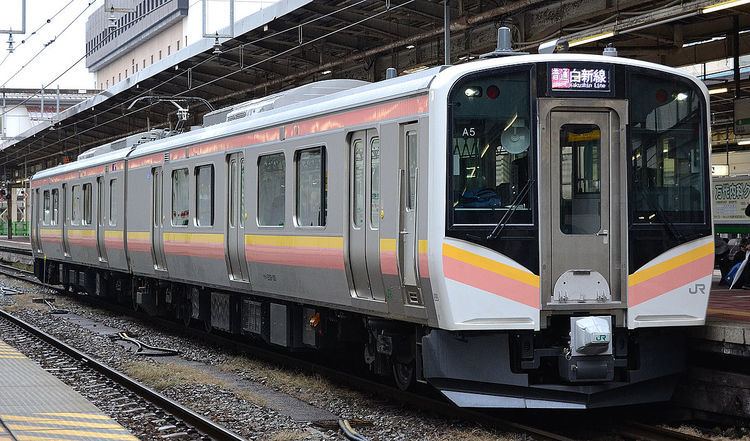In service 6 December 2014 - Constructed 2014– | Manufacturer J-TREC Number under construction 44 vehicles (11 sets) | |
 | ||
The E129 series (E129系) is a DC electric multiple unit (EMU) train type operated by East Japan Railway Company (JR East) on local services in the Niigata area since 6 December 2014.
Contents
Design
Built at the J-TREC factory in Niitsu, Niigata, the stainless steel body and "universal design" interior is derived from the E233 series commuter EMU. Externally, trains are finished in a livery with "golden yellow" (黄金イエロー) and "toki pink" (朱鷺ピンク) stripes. The trains have a maximum speed of 110 km/h (70 mph).
Operations
E129 series trains operate on the following lines, completely replacing older 115 series sets by around 2017.
The E129 series trains can operated in multiple, to form 2+2, 2+4, and 2+2+2 formations, but do not operate in multiple with E127 series trains except in emergencies.
Fleet
The E129 series fleet will ultimately consist of 30 two-car sets (60 vehicles) numbered A1 to A30 and 25 four-car sets (100 vehicles) numbered B1 to B25, all based at Niigata Depot.
2-car sets A1-A30
The two-car sets, A1 to A30, consist of two motored cars, each with one powered bogie, and are formed as shown below.
4-car sets B1-B25
The four-car sets, B1 to B25, consist of four motored cars, each with one powered bogie, and are formed as shown below.
Interior
Passenger accommodation consists of a mix of transverse seating bays and longitudinal bench seating. LED lighting is used throughout. Longitudinal seats have a width of 460 mm (1 ft 6 in) per person, 10 mm wider than for the earlier E127 series trains, and the seating pitch for transverse seating bays is 540 mm (1 ft 9 in), approximately 110 mm wider that E233 series trains. Floor height is 1,130 mm (3 ft 8 in), the same as for E127 series trains, and lower than the 1,225 mm (4 ft 0.2 in) floor height of 115 series trains.
History
Initial details of the new trains were announced by JR East in July 2013. The first two two-car sets, A1 and A2, were delivered on 8 October 2014, with test-running commencing the same day.
The first trains entered revenue service on 6 December 2014.
Fleet details
As of 1 April 2016, the fleet is as follows.
